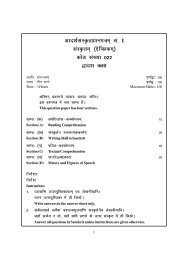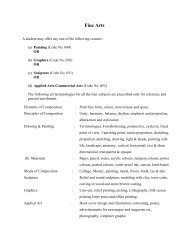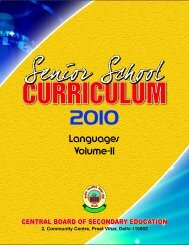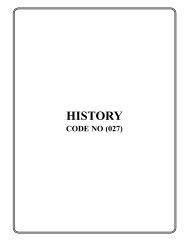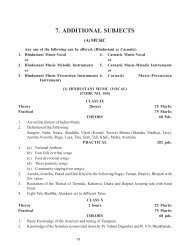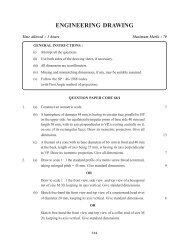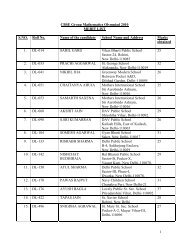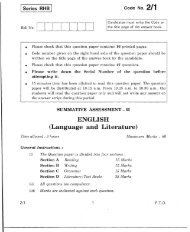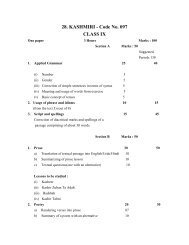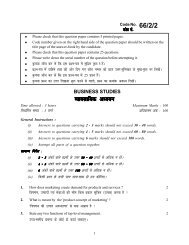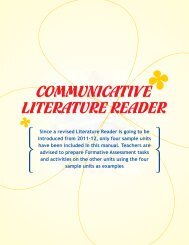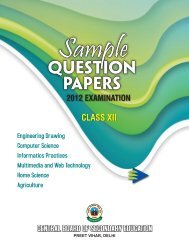sample question papers - Central Board of Secondary Education
sample question papers - Central Board of Secondary Education
sample question papers - Central Board of Secondary Education
Create successful ePaper yourself
Turn your PDF publications into a flip-book with our unique Google optimized e-Paper software.
FUNCTIONAL ENGLISH<br />
CODE NO. : 101<br />
Class – XII<br />
Sample Question Paper – II<br />
Section A : Reading Max. Marks : 20<br />
1. Read the following passage :<br />
1. MARIA AURORA COUTO’s Goa: A Daughter’s Story is an extraordinary narrative that weaves<br />
together autobiography and collective history, bringing to light a rich social and cultural tapestry<br />
little known outside its locus. Couto takes, as her demanding subject, the complex story <strong>of</strong> the<br />
Goan identity as a product <strong>of</strong> the colonial encounter between the Indic and Iberian cultures,<br />
launched by this circumstance on a trajectory distinct from his neighbours in British ruled<br />
India. Goa and its people have long had to suffer the foolish stereotypes imposed upon them by<br />
Hindi cinema, charter tourism, and fanatical Indianisers: the pernicious myths <strong>of</strong> the easy -<br />
going Goan drunkard, Goa as a kingdom <strong>of</strong> sun and sand, Goan culture as a European aberration<br />
in an Indian environment, are all dispelled by Couto’s treatment, which is distinguished by an<br />
elegance and sensitivity, a felicity <strong>of</strong> touch that masks the labour <strong>of</strong> archival research and<br />
fieldwork.<br />
2. Couto’s inquiry leads her into the records <strong>of</strong> the Portuguese colonial administration, the<br />
reminiscences <strong>of</strong> the fast-vanishing generation <strong>of</strong> mandarins, scholars and activists who grew<br />
up in colonial Goa. She re-creates vividly for us the lives <strong>of</strong> thinkers inspired by the drama that<br />
was the European Enlightenment. She imparts a flesh-and-blood reality to the generic bugaboo<br />
<strong>of</strong> “conversion”, attesting to the strategic, yet traumatic, choices made by communities faced<br />
with the Hobsonian inquisitor’s choice between preservation <strong>of</strong> religious identity and loss <strong>of</strong><br />
social and economic prestige.<br />
3. The title <strong>of</strong> Couto’s book holds its key gesture; the author speaks as the inheritor <strong>of</strong> various<br />
legacies, heirloom dilemmas, family tragedies, and sources <strong>of</strong> hope and regeneration. It is both<br />
a meditation on the persistence and lacunae <strong>of</strong> collective memory, and also a compelling account<br />
<strong>of</strong> the development <strong>of</strong> a private self through the momentous passage from colonialism to the<br />
post-colonial period. As her father’s daughter, Couto paints a moving portrait <strong>of</strong> her father, a<br />
man devoted to the refinement <strong>of</strong> sensibility, but at odds with conventional society; she<br />
memorializes the graceful, vanished milieu <strong>of</strong> cultivated intellectuals and gifted artists in Goa<br />
and Dharwar, where she grew up during the 1950s. As the daughter <strong>of</strong> a particular community,<br />
whose way <strong>of</strong> life was forever altered by the arrival <strong>of</strong>the Portuguese in 1510 A.D., Couto<br />
reflects on the Saraswat Brahmins <strong>of</strong> Goa, descendants <strong>of</strong> Kashmiri scholar-priests who became<br />
influential landowners and mandarins, and were locked into a complicated sequence <strong>of</strong><br />
negotiations with the Portuguese colonialists.<br />
4. By contrast to the simple-minded tale <strong>of</strong> ruthless conquistadors thrusting sword and cross upon<br />
hapless locals, Couto unfolds an intricate fabric <strong>of</strong> social and religious transactions,<br />
demonstrating how concessions alternated with impositions, force was succeeded by relative<br />
tolerance; and if conversion to Catholicism was used as a basis to divide Hindu families by the<br />
colonial administration, through differentials <strong>of</strong> property transfer, those who remained<br />
unconverted and marginalized staged a comeback through the espousal <strong>of</strong> trade. One lasting<br />
39



